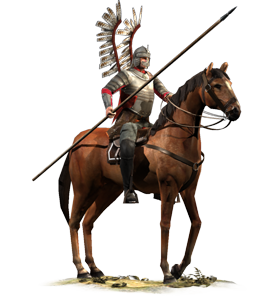Winged Hussars (ETW Unit)
| Winged Hussars (ETW Unit) | |
|---|---|
 | |
| Class | Heavy Cavalry |
| Unit Size | |
| Weaponry | |
| Morale | |
| Melee Attack | |
| Ranged Attack | |
| Defence | |
| Charge Bonus | |
| Accuracy | |
| Range | |
| Ammunition | |
| Region | Eastern Europe |
| Recruitment Cost | 1140 |
| Upkeep Cost | 340 |
| Turns to Build | |
| Unit Limit | |
| Building Requirements | |
| Technology Requirements | |
| Attributes | |
Winged Hussars are the elite cavalry of the Polish-Lithuanian commonwealth. These are available to Poland-Lithuania when you have a Army Board.
Contents
Overview
These troops are usually members of the nobility, for only they can afford the expense involved in being a member of this prestigious force. They are armed with long lances, sabres and pistols for fighting at close quarters. Their armour and elaborate uniforms, complete with two towering, feathered wings, set them apart from other “hussars”, and make them appear to be a kind of cuirassier to the uneducated eye. Their charge with levelled lances and fearsome appearance is enough to strike terror into many foot troops.
Historically, the Polish Winged Hussars had been inspired by the successes of the Hungarian hussars. Over the centuries since their establishment, they became a heavier, armoured force and, if possible, even more convinced of their elite status. The truth was somewhat different: as the 18th Century dawned, the Winged Hussars were outmoded and, in the face of disciplined firepower, no longer quite as effective as they had once been.
Origins
The Winged Hussars have a very large history in Europe and Poland, all starting in Hungary. At first starting as light cavalry in Hungary and other countries as mercenaries. Over time in Hungary, the light cavalry of the nation adapted at using Plate Armor in the medieval age. Skip forward a few decades and the same is happening in Poland. At first representing the might of polish cavalry they soon developed a persona of their own. Especially in the Siege of Vienna where the Holy League was defending against a Ottoman invasion. It is here where the might of the Winged Hussars reached their height. In this battle, the Polish forces under their own king, the same as the starting king in ETW, led the largest cavalry charge in history. The following charge led to the defeat of the Ottoman force and gave the Winged Hussars a mighty role in heavy cavalry in other nations. Historically, they wore "wings" on their backs of Scale or Plate armor to give themselves a terrifying appearance. Although the use of this is debated, most agree that they were used to make the horses death (no hearing) in order to be immune to musical bands used by the Ottomans and other nations to rout cavalry.
Tactics
These heavy cavalry are a combination of a lancer unit and heavy cavalry which can devastate up to 30%-33% of the enemy force in the charge. Against grenadiers, they are absolutely devastating, due to the small unit size of the grenadiers.
However, charging idle or standing Line Infantry means that the attack will lack the morale effects on enemy infantry, of whom will have a defense bonus.